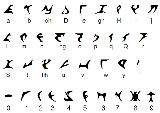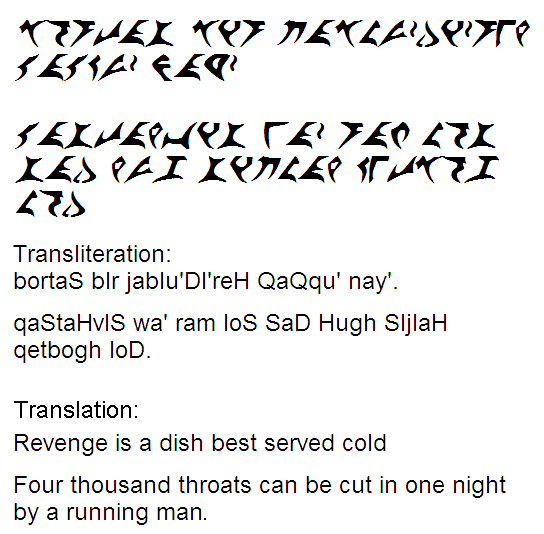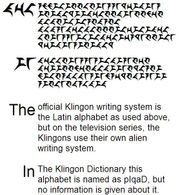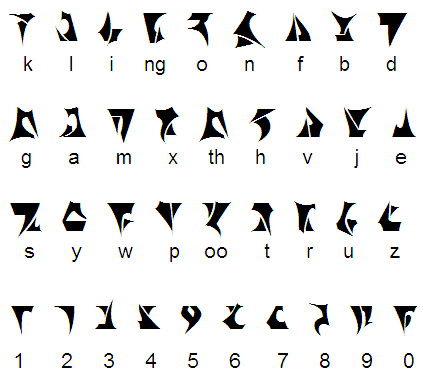
Klingon writing systems
Encyclopedia
Klingon alphabets is fictional alphabet used in the Star Trek
movies and television shows. The alien Klingons use their own alphabet
s to write the Klingon language
.
In Mark Okrand's The Klingon Dictionary
this alphabet is named as pIqaD, but no information is given about it. When Klingon symbols are used in Star Trek productions they are merely decorative graphic elements, designed to emulate real writing
and to create an appropriate atmosphere.
The Astra Image Corporation designed the symbols (currently used to "write" Klingon) for Star Trek: The Motion Picture
, although these symbols are often incorrectly attributed to Michael Okuda
. They based the letters on the Klingon battlecruiser
hull markings (three letters) first created by Matt Jeffries, and on Tibetan writing
because the script had sharp letter forms—used as a testament to the Klingons' love for bladed weapons.

 Although the Latin alphabet
Although the Latin alphabet
is used by some enthusiasts to write Klingon, the speaking community also makes use of an artificial script designed to emulate Klingon writing on the show. This alphabet was created by an anonymous source at Paramount
, who based their alphabet on letters seen in the show. This "source" sent in their alphabet to the Klingon Language Institute
and the KLI uploaded it onto their website as the Klingons' way of writing their language. This alphabet has gained some acceptance within the speaker and fan community although many Klingonists still prefer the Latin alphabet.
The alphabet is quite simple: It contains twenty-six letters with a one-to-one grapheme-phoneme correspondence: that is, one letter represents one sound and one sound is written with one letter. There are also ten numerals in the set. It is written from left to right, top to bottom like English. There is no actual punctuation; however, those that use punctuation with the alphabet, use Skybox punctuation symbols (see below).
In September 1997, Michael Everson
made a proposal for encoding this in Unicode
. The Unicode Technical Committee rejected the Klingon proposal in May 2001 on the grounds that research showed almost no use of the script for communication, and the vast majority of the people who did use Klingon employed the Latin alphabet by preference. Everson created a mapping of pIqaD into the Private Use Area of Unicode
, which he listed in the ConScript Unicode Registry
(U+F8D0 to U+F8FF ). Since then several fonts using that encoding have appeared, and software for typing in pIqaD has become available. As a result, blogs in pIqaD have begun to appear,http://qurgh.blogspot.com/ raising the possibility of reapplying for inclusion in Unicode when there is a sufficient corpus. Existing text in Romanization
can easily be converted to pIqaD also.
Google provides Klingon content, but its web server currently doesn't recognize the tlh language tag.

 The KLI pIqaD isn't the only mapping of Klingon letters. The Astra Image letters were taken and used in the Paramount-endorsed Bitstream font pack. They were used to make a font with ten letters of the English alphabet: "e" to "n" being represented by the ten different klingon letters. This font itself has been used by the Star Trek production team when creating Klingon graphics; however it is still used only as random gibberish on the shows.
The KLI pIqaD isn't the only mapping of Klingon letters. The Astra Image letters were taken and used in the Paramount-endorsed Bitstream font pack. They were used to make a font with ten letters of the English alphabet: "e" to "n" being represented by the ten different klingon letters. This font itself has been used by the Star Trek production team when creating Klingon graphics; however it is still used only as random gibberish on the shows.
The trading card company Skybox
used this font, when they created the Klingon language cards in their Star Trek: The Next Generation
trading card collection. The Klingon cards themselves detail aspects of Klingon culture, and feature pIqaD text, and a transliteration and translation provided by Marc Okrand. Some of these cards, notably S7, S8 and card S9 feature pIqaD, which corresponds to the Latin transcription.
Other known cards include s19 and s20 (which contain belittling references to Blockbuster, probably an allusion to Blockbuster Video) the season seven card selection s37, s38 and s39 (which featured no actual tlhIngan Hol, but only English and on card S39 Latin, written in the Skybox alphabet), and finally, the Checklist cards for each seasons' set of cards had the word cards written in Klingon on them when listing the above mentioned cards.
The script is written in horizontal lines running from left to right, top to bottom, just like English. Klingon can be written with spaces between words (a word being defined as any noun, verb or leftover, plus any prefixes and suffixes attached to it) and punctuation
. When this is the case, four punctuation marks are used:
The triangular punctuation marks have been accepted into the common usage of the KLI pIqaD (see above).
Klingon can also be written with no spaces or punctuation at all; this form is more common on the TV shows. As in English, Klingon text can be left-justified, center-justified, or right-justified, and written in vertical columns on banners.
Due to its nature, the "Skybox" Alphabet is ill-suited to writing Klingon, in that ambiguity in the alphabet is apparent, so different words are spelled the same way: these are homograph
s. The heartiest commendations and the gravest insults could be written identically; however, context would go a long way to disambiguating homographs.
 A third script, known as the Klinzhai or Mandel script, was included in The U.S.S. Enterprise Officer's Manual (1980). It holds more closely to the D7 battlecruiser hull markings and is also loosely based upon the conceptual art of Matt Jeffries, TOS
A third script, known as the Klinzhai or Mandel script, was included in The U.S.S. Enterprise Officer's Manual (1980). It holds more closely to the D7 battlecruiser hull markings and is also loosely based upon the conceptual art of Matt Jeffries, TOS
set designer.
Its letters map to various letters and digraphs of English, but they have no relation to Marc Okrand's Klingon language. Like the other two alphabets, it is probably written in the same direction as English.
Some fans have suggested this alphabet could be used to write Klingonaase in its native form.
Star Trek
Star Trek is an American science fiction entertainment franchise created by Gene Roddenberry. The core of Star Trek is its six television series: The Original Series, The Animated Series, The Next Generation, Deep Space Nine, Voyager, and Enterprise...
movies and television shows. The alien Klingons use their own alphabet
Alphabet
An alphabet is a standard set of letters—basic written symbols or graphemes—each of which represents a phoneme in a spoken language, either as it exists now or as it was in the past. There are other systems, such as logographies, in which each character represents a word, morpheme, or semantic...
s to write the Klingon language
Klingon language
The Klingon language is the constructed language spoken by the fictional Klingons in the Star Trek universe....
.
In Mark Okrand's The Klingon Dictionary
The Klingon Dictionary
The Klingon Dictionary is a book by Marc Okrand describing the Klingon language. First published in 1985 and then again with an addendum in 1992, it includes pronunciation, grammar and vocabulary...
this alphabet is named as pIqaD, but no information is given about it. When Klingon symbols are used in Star Trek productions they are merely decorative graphic elements, designed to emulate real writing
Writing
Writing is the representation of language in a textual medium through the use of a set of signs or symbols . It is distinguished from illustration, such as cave drawing and painting, and non-symbolic preservation of language via non-textual media, such as magnetic tape audio.Writing most likely...
and to create an appropriate atmosphere.
The Astra Image Corporation designed the symbols (currently used to "write" Klingon) for Star Trek: The Motion Picture
Star Trek: The Motion Picture
Star Trek: The Motion Picture is a 1979 American science fiction film released by Paramount Pictures. It is the first film based on the Star Trek television series. The film is set in the twenty-third century, when a mysterious and immensely powerful alien cloud called V'Ger approaches the Earth,...
, although these symbols are often incorrectly attributed to Michael Okuda
Michael Okuda
- Work in Star Trek :In the mid-1980s, he designed the look of animated computer displays for the Enterprise-A bridge in Star Trek IV: The Voyage Home. This led to a staff position on Star Trek: The Next Generation in 1987 as a scenic artist, adding detail to set designs and props...
. They based the letters on the Klingon battlecruiser
Klingon starships
In the Star Trek franchise, the Klingon Empire makes use of several classes of starships. As the Klingons are portrayed as a warrior culture, driven by the pursuit of honor and glory, the Empire is shown to use warships almost exclusively. This contrasts with the exploration and research vessels...
hull markings (three letters) first created by Matt Jeffries, and on Tibetan writing
Tibetan script
The Tibetan alphabet is an abugida of Indic origin used to write the Tibetan language as well as the Dzongkha language, Denzongkha, Ladakhi language and sometimes the Balti language. The printed form of the alphabet is called uchen script while the hand-written cursive form used in everyday...
because the script had sharp letter forms—used as a testament to the Klingons' love for bladed weapons.
KLI pIqaD


Latin alphabet
The Latin alphabet, also called the Roman alphabet, is the most recognized alphabet used in the world today. It evolved from a western variety of the Greek alphabet called the Cumaean alphabet, which was adopted and modified by the Etruscans who ruled early Rome...
is used by some enthusiasts to write Klingon, the speaking community also makes use of an artificial script designed to emulate Klingon writing on the show. This alphabet was created by an anonymous source at Paramount
Paramount Pictures
Paramount Pictures Corporation is an American film production and distribution company, located at 5555 Melrose Avenue in Hollywood. Founded in 1912 and currently owned by media conglomerate Viacom, it is America's oldest existing film studio; it is also the last major film studio still...
, who based their alphabet on letters seen in the show. This "source" sent in their alphabet to the Klingon Language Institute
Klingon Language Institute
The Klingon Language Institute is an independent organization located in Flourtown, Pennsylvania, USA. Its goal is to promote the Klingon language and culture.- General :About 2500 members in over 50 countries all over the world have joined the KLI...
and the KLI uploaded it onto their website as the Klingons' way of writing their language. This alphabet has gained some acceptance within the speaker and fan community although many Klingonists still prefer the Latin alphabet.
The alphabet is quite simple: It contains twenty-six letters with a one-to-one grapheme-phoneme correspondence: that is, one letter represents one sound and one sound is written with one letter. There are also ten numerals in the set. It is written from left to right, top to bottom like English. There is no actual punctuation; however, those that use punctuation with the alphabet, use Skybox punctuation symbols (see below).
In September 1997, Michael Everson
Michael Everson
Michael Everson is a linguist, script encoder, typesetter, and font designer. His central area of expertise is with writing systems of the world, specifically in the representation of these systems in formats for computer and digital media...
made a proposal for encoding this in Unicode
Unicode
Unicode is a computing industry standard for the consistent encoding, representation and handling of text expressed in most of the world's writing systems...
. The Unicode Technical Committee rejected the Klingon proposal in May 2001 on the grounds that research showed almost no use of the script for communication, and the vast majority of the people who did use Klingon employed the Latin alphabet by preference. Everson created a mapping of pIqaD into the Private Use Area of Unicode
Unicode
Unicode is a computing industry standard for the consistent encoding, representation and handling of text expressed in most of the world's writing systems...
, which he listed in the ConScript Unicode Registry
ConScript Unicode Registry
The ConScript Unicode Registry is a volunteer project to coordinate the assignment of code points in the Unicode Private Use Area for the encoding of artificial scripts. It was founded by and is maintained by John Cowan and Michael Everson...
(U+F8D0 to U+F8FF ). Since then several fonts using that encoding have appeared, and software for typing in pIqaD has become available. As a result, blogs in pIqaD have begun to appear,http://qurgh.blogspot.com/ raising the possibility of reapplying for inclusion in Unicode when there is a sufficient corpus. Existing text in Romanization
Romanization
In linguistics, romanization or latinization is the representation of a written word or spoken speech with the Roman script, or a system for doing so, where the original word or language uses a different writing system . Methods of romanization include transliteration, for representing written...
can easily be converted to pIqaD also.
Google provides Klingon content, but its web server currently doesn't recognize the tlh language tag.
Skybox pIqaD


The trading card company Skybox
SkyBox International
SkyBox International Inc. was an American trading card manufacturing company based in Durham, North Carolina. A subsidiary of Vector Group, it was originally formed as Impel Marketing in 1989. In 1990, the company was renamed SkyBox International...
used this font, when they created the Klingon language cards in their Star Trek: The Next Generation
Star Trek: The Next Generation
Star Trek: The Next Generation is an American science fiction television series created by Gene Roddenberry as part of the Star Trek franchise. Roddenberry, Rick Berman, and Michael Piller served as executive producers at different times throughout the production...
trading card collection. The Klingon cards themselves detail aspects of Klingon culture, and feature pIqaD text, and a transliteration and translation provided by Marc Okrand. Some of these cards, notably S7, S8 and card S9 feature pIqaD, which corresponds to the Latin transcription.
Other known cards include s19 and s20 (which contain belittling references to Blockbuster, probably an allusion to Blockbuster Video) the season seven card selection s37, s38 and s39 (which featured no actual tlhIngan Hol, but only English and on card S39 Latin, written in the Skybox alphabet), and finally, the Checklist cards for each seasons' set of cards had the word cards written in Klingon on them when listing the above mentioned cards.
The script is written in horizontal lines running from left to right, top to bottom, just like English. Klingon can be written with spaces between words (a word being defined as any noun, verb or leftover, plus any prefixes and suffixes attached to it) and punctuation
Punctuation
Punctuation marks are symbols that indicate the structure and organization of written language, as well as intonation and pauses to be observed when reading aloud.In written English, punctuation is vital to disambiguate the meaning of sentences...
. When this is the case, four punctuation marks are used:
- An "up-turned triangle" with a function similar to a commaCommaA comma is a type of punctuation mark . The word comes from the Greek komma , which means something cut off or a short clause.Comma may also refer to:* Comma , a type of interval in music theory...
, semi-colon or colonColon (punctuation)The colon is a punctuation mark consisting of two equally sized dots centered on the same vertical line.-Usage:A colon informs the reader that what follows the mark proves, explains, or lists elements of what preceded the mark....
. - A "down-turned" triangle with a function similar to a full stopFull stopA full stop is the punctuation mark commonly placed at the end of sentences. In American English, the term used for this punctuation is period. In the 21st century, it is often also called a dot by young people...
, question markQuestion markThe question mark , is a punctuation mark that replaces the full stop at the end of an interrogative sentence in English and many other languages. The question mark is not used for indirect questions...
or exclamation markExclamation markThe exclamation mark, exclamation point, or bang, or "dembanger" is a punctuation mark usually used after an interjection or exclamation to indicate strong feelings or high volume , and often marks the end of a sentence. Example: “Watch out!” The character is encoded in Unicode at...
. - A mark similar in appearance to a hyphenHyphenThe hyphen is a punctuation mark used to join words and to separate syllables of a single word. The use of hyphens is called hyphenation. The hyphen should not be confused with dashes , which are longer and have different uses, or with the minus sign which is also longer...
(unknown function). - A mark similar to an apostrophe (From KLI) (unknown)
The triangular punctuation marks have been accepted into the common usage of the KLI pIqaD (see above).
Klingon can also be written with no spaces or punctuation at all; this form is more common on the TV shows. As in English, Klingon text can be left-justified, center-justified, or right-justified, and written in vertical columns on banners.
Due to its nature, the "Skybox" Alphabet is ill-suited to writing Klingon, in that ambiguity in the alphabet is apparent, so different words are spelled the same way: these are homograph
Homograph
A homograph is a word or a group of words that share the same written form but have different meanings. When spoken, the meanings may be distinguished by different pronunciations, in which case the words are also heteronyms. Words with the same writing and pronunciation A homograph (from the ,...
s. The heartiest commendations and the gravest insults could be written identically; however, context would go a long way to disambiguating homographs.
Mandel script

Star Trek: The Original Series
Star Trek is an American science fiction television series created by Gene Roddenberry, produced by Desilu Productions . Star Trek was telecast on NBC from September 8, 1966, through June 3, 1969...
set designer.
Its letters map to various letters and digraphs of English, but they have no relation to Marc Okrand's Klingon language. Like the other two alphabets, it is probably written in the same direction as English.
Some fans have suggested this alphabet could be used to write Klingonaase in its native form.
External links
- Klingon Language Institute (KLI)
- Omniglot: Klingon Alphabet
- information on the Skybox Trading cards, with Klingon writing
- Installer for a custom Klingon locale, keyboard mapping and pIqaD font for Windows Vista/Windows 7
- Custom keyboard mapping for Windows XP
- custom locale for using Klingon pIqaD on Windows Vista, font, keyboard and custom locale
- Transliterate Between pIqaD and Latin alphabet transcription
- Hol-pIqaD font used for the eurotalk Talk Now! Learn Klingon course by Jonathan Brown and Marc Okrand. Change case to convert between a Latin and pIqaD characters

